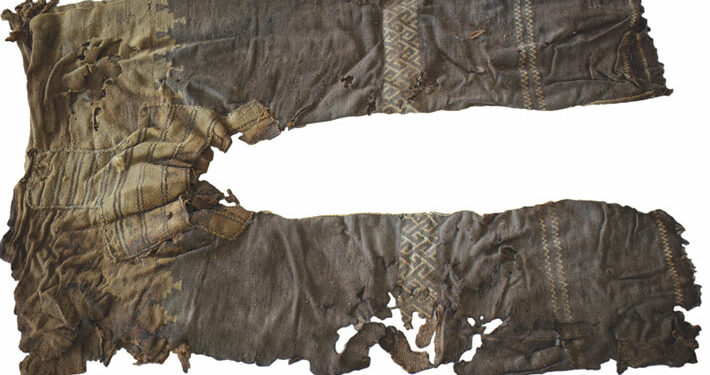Whatever rain falls in a gravelly desert in western China’s Tarim Basin evaporates as soon as it strikes the scorching ground. The ancient remains of humans who made one of the biggest fashion splashes of all time lie here, in this dry wasteland.
Pants were first made by herders and horse riders who buried their dead in the Tarim Basin’s Yanghai graveyard between 3,200 and 3,000 years ago. Their clever blend of weaving techniques and artistic patterns — which reflected influences from across Eurasia — resulted in a pair of attractive yet durable trousers that are now considered the world’s oldest such garment (SN: 5/30/14).
An international team of archaeologists, fashion designers, geoscientists, chemists, and custodians has now deciphered how those trousers were constructed and meticulously recreated a modern version.
The researchers explain in March Archaeological Research in Asia that the vintage slacks tell a story about not only textile development but also how cultural practices spread across Asia.

Without saying anything, one man brought the pants to the scientists’ attention. His naturally mummified body, along with the preserved bodies of over 500 others, was discovered during excavations at the Shanghai cemetery by Chinese researchers in the early 1970s.
He wore a wool headband with four bronze disks and two seashells sewn on it, as well as trousers, a poncho belted at the waist, one pair of braided bands to fasten the trouser legs below the knees, another pair to fasten soft leather boots at the ankles, and one pair of braided bands to fasten the trouser legs below the knees. He was buried with a leather bridle, wooden horse bit, and battle-ax, indicating that he was a horse-riding warrior.
Turfan Man is the name given to him by researchers because the Shanghai location is located 43 kilometers southeast of Turfan, China.
Turfan Man’s trousers stood out among all of his outfits as absolutely unique. The Shanghai pants were not only centuries older than any previous specimen of such clothing, but they also had a refined, modern appearance. Two leg sections gradually widen at the top of the pants, which are connected by a crotch piece that widens and bunches in the middle to promote leg mobility.
Other archaeological findings demonstrate that migratory populations across Eurasia began wearing pants similar to those seen at Yanghai within a few hundred years. The hardship of riding horses bareback over long distances was relieved by woven leg covers joined by a flexible crotch piece. Mounted armies made their debut about the same time.
Denim jeans and formal slacks that combine the design and production characteristics of the traditional Shanghai pants are worn by people all over the world today. Turfan Man was, in a nutshell, the ultimate trendsetter.
Pants with a flair
Despite being so fashionable, scholars are baffled as to how the ancient Yanghai horseman’s amazing pants were created. Because there were no signs of cutting on the cloth, Wagner’s team assumed the garment had been fashioned to suit its wearer.
The experts explain in their new study that a close analysis of Turfan Man’s trousers shows a blend of three weaving techniques. That observation was corroborated by a re-created version of the find, which was woven by an expert weaver from the yarn of coarse-wooled sheep comparable to those whose wool was utilized by ancient Yanghai weavers.
Twill weave, an important innovation in the history of textiles, is used for a large portion of the garment.
Twill alters the texture of woven wool from hard to elastic, allowing a person to move freely while wearing tight-fitting pants. The fabric is made by weaving a pattern of parallel, diagonal lines with rods on a loom.
Warp threads are maintained in place lengthwise to allow a row of weft threads to pass over and under them at regular intervals. For each subsequent row, the beginning point of this weaving pattern shifts slightly to the right or left, forming a diagonal line.
The researchers discovered that the researchers employed variations in the quantity and color of weft threads in the twill weave on Turfan Man’s trousers to generate pairs of brown stripes running up the off-white crotch section.
When textile archaeologist Karina Grömer of the Natural History Museum Vienna inspected Turfan Man’s trousers five years ago, she recognized twill weave.
Grömer earlier reported that the earliest known twill weave was found in fragments of woven cloth recovered in Austria’s Hallstatt salt mine, where such fragile textiles survive well. The Hallstatt textiles are estimated to be between 3,500 and 3,200 years old, around 200 years before the Turfan man wore his britches.
Twill weaving may have been originated independently in Europe and Central Asia, according to Grömer, who was not involved in the new study. Weavers at the Shanghai site, on the other hand, used twill in combination with various weaving techniques and unique designs to create high-quality riding pants.
Grömer warns, “This is not a beginner’s item.” “It’s like the Rolls-Royce of trousers,” says the author.
Consider the knee parts of old trousers. The researchers discovered that a technique known as tapestry weaving produced a thicker, more protective cloth at these points. To generate a thick waistline, a third weaving method was applied on the upper border of the pants.
The trousers also included a distinctive twining technique in which two different colored weft threads were twisted around each other by the hand and interwoven through warp threads to create a colorful, geometric design across the knees that resembles interlocking T’s leaning to the side. At the ankles and calves of the trousers, the same twining procedure generated zigzag stripes.
Only a few historical examples of such twining were found by Wagner’s team, including borders on Maori cloaks, an Indigenous group in New Zealand.
Shanghai artisans also demonstrated their innovation by creating a form-fitting crotch piece that was wider in the middle than at the ends, according to Grömer. Trousers unearthed in numerous places of Asia a few hundred years later than the Yanghai find generally had woven legs joined by square cloth crotch sections, resulting in a less comfortable and flexible fit. The trousers fit tightly while allowing the legs to clamp firmly around the horse in tests with a man riding a horse bareback while wearing a re-created version of Turfan Man’s whole outfit.
Denim jeans are manufactured today from a single piece of twill fabric, using some of the same design ideas as Yanghai pants from three millennia ago.
Connections between clothes
Turfan Man’s trousers, for example, illustrate the narrative of how ancient herding cultures dispersed seeds of innovation across Asia by carrying their cultural practices and expertise.
The interlocking T design on the ancient horseman’s breeches at the knees, for example, can be found on bronze vessels from approximately the same time, roughly 3,300 years ago, according to Wagner’s research. The practically simultaneous adoption of this geometric form in Central and East Asia corresponds to the advent in those regions of herders from West Eurasian grasslands riding horses they domesticated 4,200 years or more ago (SN: 10/20/21).
Interlocking T’s can also be seen on pottery found at the horse riders’ homes in western Siberia and Kazakhstan. Aside from its artistic attractiveness, there is no deeper meaning to this pattern. Wagner and her colleagues believe that West Eurasian horse breeders disseminated the interlocking T design across most of ancient Asia.
A stepped pyramid design woven onto Yanghai pants can also be found on pottery from Central Asia’s Petrovka civilization, which dates back between 3,900 and 3,750 years. According to the experts, the same pattern mimics architectural styles from more than 4,000 years ago from western and southwestern Asian and Middle Eastern nations, such as Mesopotamian stepped pyramids. Tapestry weaving, like the one seen on Turfan Man’s slacks, was also developed in those societies.
According to anthropologist Michael Frachetti of Washington University in St. Louis, it’s no surprise that ancient inhabitants in the Tarim Basin were influenced by cultural influences from throughout Asia. Since more than 4,000 years ago, the Shanghai people have lived in a place at a crossroads of seasonal migration routes followed by herding groups (SN: 3/8/17). These routes ran from Central and East Asia’s the Altai Mountains to Iran’s current location in Southwest Asia. Herders introduced crops over much of Asia, according to excavations at sites along those pathways (SN: 4/2/14).
In the Tarim Basin, cultural shifts may have begun even earlier. Western Asian herders in oxen-drawn wagons traversed most of Europe and Asia roughly 5,000 years ago, according to ancient DNA (SN: 11/15/17).
Herders’ migration paths became part of the Silk Road, a commercial and transit network that ran from China to Europe some 2,000 years ago. As thousands of small routes across Eurasia formed a huge network, cultural mixing and mingling developed.
Turfan Man’s multi-cultural riding breeches demonstrate how, even in the early phases of the Silk Road, nomadic herders brought new ideas and customs to far-flung communities. “The Shanghai pants are a starting point for looking at how the Silk Road changed the world,” explains Frachetti.
Unanswered questions
A more fundamental puzzle is how Yanghai tailors created Turfan Man’s trousers from yarn made from sheep’s wool. Wagner’s team is still unsure what an old Shanghai loom looked like, even after replicating the pants on a modern loom. There have been no traces of the devices discovered.
The researchers believe that an elaborate, twined design could have been created using a loom that could be controlled from a sitting position. Experiments with various weaving devices will be the next stage in figuring out how Turfan Man’s trousers were constructed, according to Wagner.
However, archaeologist and linguist Elizabeth Barber of Occidental College in Los Angeles believes that the builders of these ancient pants combined multiple sophisticated processes into a breakthrough item of clothing. Barber has spent time in West Asia researching the origins and evolution of textile and apparel.
Barber says, “We genuinely know so little about how talented the ancient weavers were.” Turfan Man might not have had time to think about his tailoring prowess. He was ready to ride with a pair of jeans like that.
























